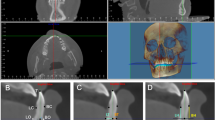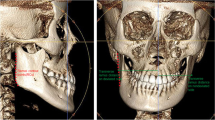Abstract
Objectives
The purpose of this study was to evaluate mandibular asymmetry in youngsters with posterior unilateral crossbite (PUXB), through cone-beam computed tomography and reverse engineering technique, before and after rapid maxillary expansion (RME) treatment.
Materials and methods
Forty cone-beam computed tomography (CBCT) images were obtained from all patients at two time points, namely T0 acquired before the placement of a Hyrax expander and T1 after appliance removal. The CBCT scans were segmented and volume rendered into a surface there-dimensional (3D) mesh model. Thereafter, mandibular models were digitally registered by using a “best-fit” algorithm. Surface and volumetric changes, between T0 and T1, were compared by using Student’s t tests.
Results
A slight increase of 0.45 cm3 of the total mandibular volume was found at T1 when compared with T0 (p < 0.001). The mandibular hemi-volume on the crossbite side (CB) was slightly smaller than the non-crossbite side both at T0 and T1. However, the mean differences of hemi-volume from the CB (crossbite) and non-CB side between T0 and T1 show a decrease of 0.26 cm3 (p < 0.001). Findings for the surface-to-surface deviation analysis demonstrated a fine percentage of matching at T0 which slightly improved at T1 (p < 0.001).
Conclusions
Youngsters affected by PUXB showed a very slight and not statistically significant volumetric and morphological asymmetry between CB side and non-CB side at T0. However, the change in mean differences of 0.26 cm cannot be considered clinically relevant.
Clinical relevance
Mandibles in young PUXB patients exhibit only a very mild mandibular asymmetry. Although the statistically significant mean change found right after RME removal cannot be considered clinically relevant, a more consistent sample and a longer follow-up could be of interest in explaining the short-term findings.







Similar content being viewed by others
References
Bjoerk A, Krebs A, Solow B (1964) A method for epidemiological registration of malocclusion. Acta Odontol Scand 22:27–41
Iodice G, Danzi G, Cimino R, Paduano S, Michelotti A (2016) Association between posterior crossbite, skeletal, and muscle asymmetry: a systematic review. Eur J Orthod 38:638–651. https://doi.org/10.1093/ejo/cjw003
Kutin G, Hawes RR (1969) Posterior cross-bites in the deciduous and mixed dentitions. Am J Orthod 56:491–504
Egermark-Eriksson I, Carlsson GE, Magnusson T, Thilander B (1990) A longitudinal study on malocclusion in relation to signs and symptoms of cranio-mandibular disorders in children and adolescents. Eur J Orthod 12:399–407
Zhu JF, Crevoisier R, King DL, Henry R, Mills CM (1996) Posterior crossbites in children. Compend Contin Educ Dent 17:1051–1054 1056, 1058
Schroder U, Schroder I (1984) Early treatment of unilateral posterior crossbite in children with bilaterally contracted maxillae. Eur J Orthod 6:65–69
Baka ZM, Akin M, Ucar FI, Ileri Z (2015) Cone-beam computed tomography evaluation of dentoskeletal changes after asymmetric rapid maxillary expansion. Am J Orthod Dentofac Orthop 147:61–71. https://doi.org/10.1016/j.ajodo.2014.09.014
Rilo B, da Silva JL, Mora MJ, Cadarso-Suarez C, Santana U (2008) Midline shift and lateral guidance angle in adults with unilateral posterior crossbite. Am J Orthod Dentofac Orthop 133:804–808. https://doi.org/10.1016/j.ajodo.2006.05.046
Veli I, Uysal T, Ozer T, Ucar FI, Eruz M (2011) Mandibular asymmetry in unilateral and bilateral posterior crossbite patients using cone-beam computed tomography. Angle Orthod 81:966–974. https://doi.org/10.2319/022011-122.1
Langberg BJ, Arai K, Miner RM (2005) Transverse skeletal and dental asymmetry in adults with unilateral lingual posterior crossbite. Am J Orthod Dentofac Orthop 127:6–15; discussion 15–6. https://doi.org/10.1016/j.ajodo.2003.10.044
O'Byrn BL, Sadowsky C, Schneider B, BeGole EA (1995) An evaluation of mandibular asymmetry in adults with unilateral posterior crossbite. Am J Orthod Dentofac Orthop 107:394–400
Talapaneni AK, Nuvvula S (2012) The association between posterior unilateral crossbite and craniomandibular asymmetry: a systematic review. J Orthod 39:279–291. https://doi.org/10.1179/1465312512z.00000000041
Ferro F, Spinella P, Lama N (2011) Transverse maxillary arch form and mandibular asymmetry in patients with posterior unilateral crossbite. Am J Orthod Dentofac Orthop 140:828–838. https://doi.org/10.1016/j.ajodo.2011.08.003
Kilic N, Kiki A, Oktay H (2008) Condylar asymmetry in unilateral posterior crossbite patients. Am J Orthod Dentofac Orthop 133:382–387. https://doi.org/10.1016/j.ajodo.2006.04.041
Uysal T, Sisman Y, Kurt G, Ramoglu SI (2009) Condylar and ramal vertical asymmetry in unilateral and bilateral posterior crossbite patients and a normal occlusion sample. Am J Orthod Dentofac Orthop 136:37–43. https://doi.org/10.1016/j.ajodo.2007.06.019
Lam PH, Sadowsky C, Omerza F (1999) Mandibular asymmetry and condylar position in children with unilateral posterior crossbite. Am J Orthod Dentofac Orthop 115:569–575
Pinto AS, Buschang PH, Throckmorton GS, Chen P (2001) Morphological and positional asymmetries of young children with functional unilateral posterior crossbite. Am J Orthod Dentofac Orthop 120:513–520. https://doi.org/10.1067/mod.2001.118627a
Spampinato C, Pino C, Giordano D, Leonardi R (2012) Automatic 3D segmentation of mandible for assessment of facial asymmetry
Halicioglu K, Celikoglu M, Yavuz I, Sekerci AE, Buyuk SK (2014) An evaluation of condylar and ramal vertical asymmetry in adolescents with unilateral and bilateral posterior crossbite using cone beam computed tomography (CBCT). Aust Orthod J 30:11–18
Illipronti-Filho E, Fantini SM, Chilvarquer I (2015) Evaluation of mandibular condyles in children with unilateral posterior crossbite. Braz Oral Res 29:49. https://doi.org/10.1590/1807-3107BOR-2015.vol29.0049
Cardinal L, Martins I, Gribel BF, Dominguez GC (2019) Is there an asymmetry of the condylar and coronoid processes of the mandible in individuals with unilateral crossbite? Angle Orthod 89:464–469. https://doi.org/10.2319/052518-398.1
Evangelista K, de Oliveira CFP, de Almeida BL, Avelino MAG, Cevidanes LHS, de Oliveira Ruellas AC, Valladares-Neto J, Silva MAG (2020) Three-dimensional assessment of craniofacial asymmetry in children with transverse maxillary deficiency after rapid maxillary expansion: a prospective study. Orthod Craniofac Res. https://doi.org/10.1111/ocr.12370
Jaju PP, Jaju SP (2015) Cone-beam computed tomography: time to move from ALARA to ALADA. Imaging Sci Dent 45:263–265. https://doi.org/10.5624/isd.2015.45.4.263
Kavand G, Lagravere M, Kula K, Stewart K, Ghoneima A (2019) Retrospective CBCT analysis of airway volume changes after bone-borne vs tooth-borne rapid maxillary expansion. Angle Orthod 89:566–574. https://doi.org/10.2319/070818-507.1
Pham V, Lagravere MO (2017) Alveolar bone level changes in maxillary expansion treatments assessed through CBCT. Int Orthod 15:103–113. https://doi.org/10.1016/j.ortho.2016.12.002
Digregorio MV, Fastuca R, Zecca PA, Caprioglio A, Lagravere MO (2019) Buccal bone plate thickness after rapid maxillary expansion in mixed and permanent dentitions. Am J Orthod Dentofac Orthop 155:198–206. https://doi.org/10.1016/j.ajodo.2018.03.020
Forst D, Nijjar S, Flores-Mir C, Carey J, Secanell M, Lagravere M (2014) Comparison of in vivo 3D cone-beam computed tomography tooth volume measurement protocols. Progr Orthod 15. https://doi.org/10.1186/s40510-014-0069-2
Leonardi R (2019) Cone-beam computed tomography and three-dimensional orthodontics. Where we are and future perspectives. J Orthod 46:45–48. https://doi.org/10.1177/1465312519840029
Leonardi R, Muraglie S, Bennici O, Cavallini C, Spampinato C (2019) Three-dimensional analysis of mandibular functional units in adult patients with unilateral posterior crossbite: a cone beam study with the use of mirroring and surface-to-surface matching techniques. Angle Orthod 89:590–596. https://doi.org/10.2319/081718-607.1
Leonardi R, Muraglie S, Crimi S, Pirroni M, Musumeci G, Perrotta R (2018) Morphology of palatally displaced canines and adjacent teeth, a 3-D evaluation from cone-beam computed tomographic images. BMC Oral Health 18:156. https://doi.org/10.1186/s12903-018-0617-0
Leonardi R, Muraglie S, Lo Giudice A, Aboulazm KS, Nucera R (2020) Evaluation of mandibular symmetry and morphology in adult patients with unilateral posterior crossbite: a CBCT study using a surface-to-surface matching technique. Eur J Orthod. https://doi.org/10.1093/ejo/cjz106
Lee SY, Choi DS, Jang I, Song GS, Cha BK (2017) The genial tubercle: A prospective novel landmark for the diagnosis of mandibular asymmetry. Korean J Orthod 47:50–58. https://doi.org/10.4041/kjod.2017.47.1.50
Neiva MB, Soares AC, Lisboa Cde O, Vilella Ode V, Motta AT (2015) Evaluation of cephalometric landmark identification on CBCT multiplanar and 3D reconstructions. Angle Orthod 85:11–17. https://doi.org/10.2319/120413-891.1
G. D (1940) Statistical methods for medical and biological students. Interscience Publications, New York
Alarcon JA, Martin C, Palma JC (2000) Effect of unilateral posterior crossbite on the electromyographic activity of human masticatory muscles. Am J Orthod Dentofac Orthop 118:328–334. https://doi.org/10.1067/mod.2000.103252
Bresin A, Kiliaridis S, Strid KG (1999) Effect of masticatory function on the internal bone structure in the mandible of the growing rat. Eur J Oral Sci 107:35–44
Kiliaridis S, Mahboubi PH, Raadsheer MC, Katsaros C (2007) Ultrasonographic thickness of the masseter muscle in growing individuals with unilateral crossbite. Angle Orthod 77:607–611. https://doi.org/10.2319/101105-360
Rodrigues L, Traina AA, Nakamai LF, Luz JG (2009) Effects of the unilateral removal and dissection of the masseter muscle on the facial growth of young rats. Braz Oral Res 23:89–95
Sarnat BG (1988) Craniofacial change and non-change after experimental surgery in young and adult animals. Angle Orthod 58:321–342. https://doi.org/10.1043/0003-3219(1988)058<0321:CCANAE>2.0.CO;2
Tsanidis N, Antonarakis GS, Kiliaridis S (2016) Functional changes after early treatment of unilateral posterior cross-bite associated with mandibular shift: a systematic review. J Oral Rehabil 43:59–68. https://doi.org/10.1111/joor.12335
Nerder PH, Bakke M, Solow B (1999) The functional shift of the mandible in unilateral posterior crossbite and the adaptation of the temporomandibular joints: a pilot study. Eur J Orthod 21:155–166
Bazina M, Cevidanes L, Ruellas A, Valiathan M, Quereshy F, Syed A, Wu R, Palomo JM (2018) Precision and reliability of Dolphin 3-dimensional voxel-based superimposition. Am J Orthod Dentofac Orthop 153:599–606. https://doi.org/10.1016/j.ajodo.2017.07.025
Solem RC, Ruellas A, Ricks-Oddie JL, Kelly K, Oberoi S, Lee J, Miller A, Cevidanes L (2016) Congenital and acquired mandibular asymmetry: mapping growth and remodeling in 3 dimensions. Am J Orthod Dentofac Orthop 150:238–251. https://doi.org/10.1016/j.ajodo.2016.02.015
Almukhtar A, Ju X, Khambay B, McDonald J, Ayoub A (2014) Comparison of the accuracy of voxel based registration and surface based registration for 3D assessment of surgical change following orthognathic surgery. PLoS One 9:e93402. https://doi.org/10.1371/journal.pone.0093402
Muraglie S, Musumeci G, Loreto C, Leonardi RM (2019) Role of ADAMTS4 and ADAMTS5 during early orthodontic tooth movement. J Biol Regul Homeost Agents 33:649–655
Bishara SE, Burkey PS, Kharouf JG (1994) Dental and facial asymmetries: a review. Angle Orthod 64:89–98. https://doi.org/10.1043/0003-3219(1994)064<0089:DAFAAR>2.0.CO;2
Patcas R, Wiedemeier DB, Markic G, Beit P, Keller H (2017) Evidence of secular trend in mandibular pubertal growth. Eur J Orthod 39:680–685. https://doi.org/10.1093/ejo/cjx027
Hagg U, Du X, Rabie AB (2002) Initial and late treatment effects of headgear-Herbst appliance with mandibular step-by-step advancement. Am J Orthod Dentofac Orthop 122:477–485. https://doi.org/10.1067/mod.2002.128218
Funding
This work has been performed with funds of the Department of General Surgery and Surgical-Medical Specialties, University of Catania, Catania, Italy.
Author information
Authors and Affiliations
Corresponding author
Ethics declarations
Conflict of interest
All authors declare that they have no conflict of interest.
Ethical approval
All procedures performed in studies involving human participants were in accordance with the ethical standards of the institutional and/or national research committee and with the 1964 Helsinki declaration and its later amendments or comparable ethical standards. Ethical approval was obtained from the Institutional Review Board of Indiana University-Purdue University (IRB protocol number: 1708606623).
Informed consent
Informed consent was obtained from all individual participants included in the study
Additional information
Publisher’s note
Springer Nature remains neutral with regard to jurisdictional claims in published maps and institutional affiliations.
Rights and permissions
About this article
Cite this article
Leonardi, R.M., Aboulazm, K., Giudice, A.L. et al. Evaluation of mandibular changes after rapid maxillary expansion: a CBCT study in youngsters with unilateral posterior crossbite using a surface-to-surface matching technique. Clin Oral Invest 25, 1775–1785 (2021). https://doi.org/10.1007/s00784-020-03480-5
Received:
Accepted:
Published:
Issue Date:
DOI: https://doi.org/10.1007/s00784-020-03480-5




